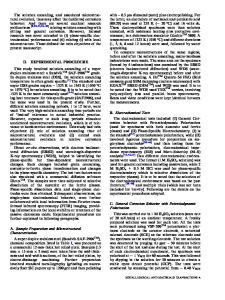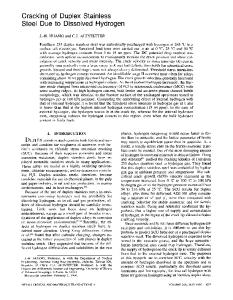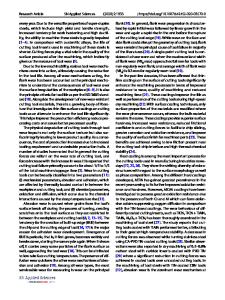Mechanical Properties of Super Duplex Stainless Steel 2507 after Gas Phase Thermal Precharging with Hydrogen
- PDF / 934,803 Bytes
- 13 Pages / 593.972 x 792 pts Page_size
- 20 Downloads / 301 Views
INTRODUCTION
GASEOUS hydrogen is being considered as a means of storing and transporting energy as well as a cleaner burning fuel. As the energy sector builds infrastructure in anticipation of more pervasive use of hydrogen, many questions arise about the compatibility of structural materials with hydrogen. A number of high profile failures of pressure vessels and ancillary components in hydrogen gas storage systems have been associated with hydrogen uptake into the metal and subsequent hydrogen-assisted fracture.[1,2] Single-phase, austenitic stainless steels are generally considered to have excellent environmental compatibility, including resistance to hydrogen-assisted fracture.[2] However, austenitic stainless steels have relatively low strength, creating an economic burden on high-pressure infrastructure compared to systems that can reduce capital costs by using high-strength materials. Duplex stainless steels consisting of austenite (c) plus ferrite (a) are used as a highstrength, corrosion-resistant alternative to the singlephase austenitic grades. The hydrogen compatibility of these steels must be characterized, because both ferrite C. SAN MARCHI, Senior Member of Technical Staff, and B.P. SOMERDAY, Principal Member of Technical Staff, are with the Sandia National Laboratories, Livermore, CA 94550, USA. Contact e-mail: [email protected] J. ZELINSKI, Engineer, is formerly with the Defense Nuclear Facilities Safety Board, Washington, DC 20004, USA. X. TANG, Lead Metallurgical Engineer, and G.H. SCHIROKY, Senior Scientist, are with the Swagelok Company, Solon, OH 44139, USA. Manuscript submitted October 4, 2006. Article published online September 13, 2007 METALLURGICAL AND MATERIALS TRANSACTIONS A
microstructures and high strength tend to render steels more susceptible to hydrogen-assisted fracture.[2] The literature on gaseous hydrogen compatibility of duplex stainless steels reports a significant reduction in the tensile ductility of 2205 duplex stainless steel tested in hydrogen gas and tested in air with internal hydrogen.[3–6] We extend the study of internal hydrogen on duplex stainless steels to a more highly alloyed system (2507), and use fracture mechanics methods to quantify fracture behavior of this material to show that 2507 has similar susceptibility to hydrogen-assisted fracture as single-phase austenitic stainless steels and precipitationstrengthened austenitic stainless steels in high-strength conditions. II.
EXPERIMENTAL PROCEDURES
Super duplex stainless steel called 2507 (nominally 25 wt pct Cr and 7 wt pct Ni) was used in this study; the composition as provided by the supplier is given in Table I. The material (UNS S32750) was supplied as 19–mm-diameter round bar in the annealed and strainhardened conditions from the same heat of material with a nominal phase distribution of 50 pct austenite, 50 pct ferrite. Standard optical and electron microscopy techniques were used to analyze the microstructures and fracture surfaces. The microstructure was revealed by a two-step etch: (1) 10 pct oxalic
Data Loading...











